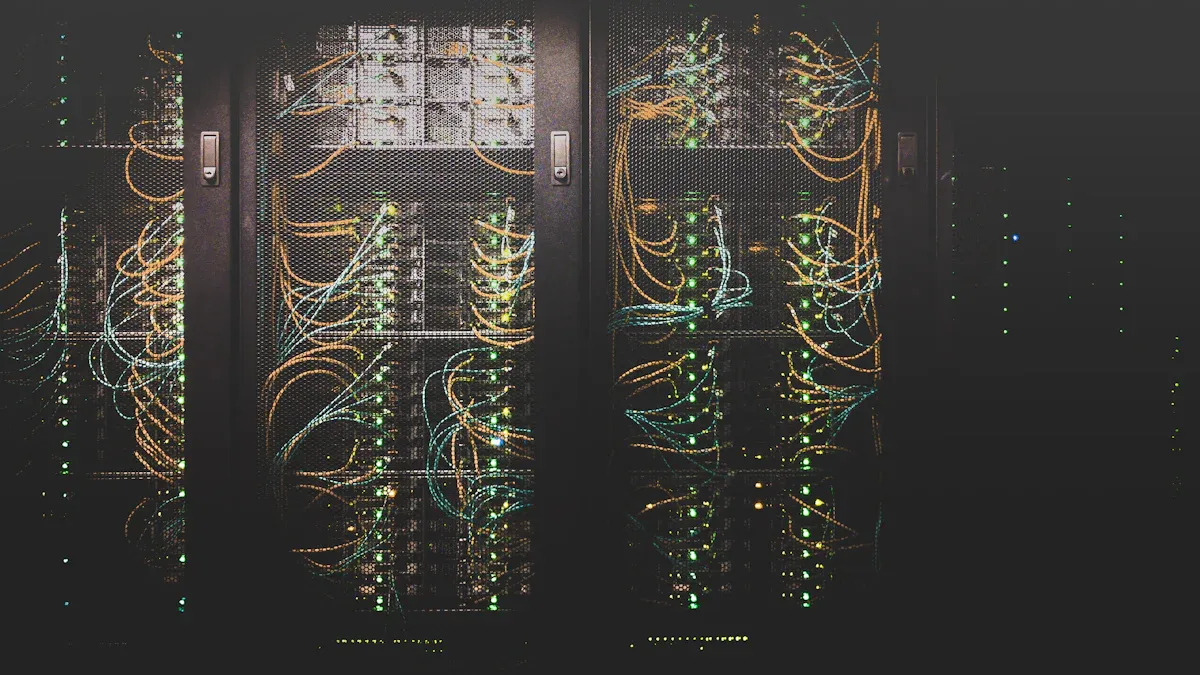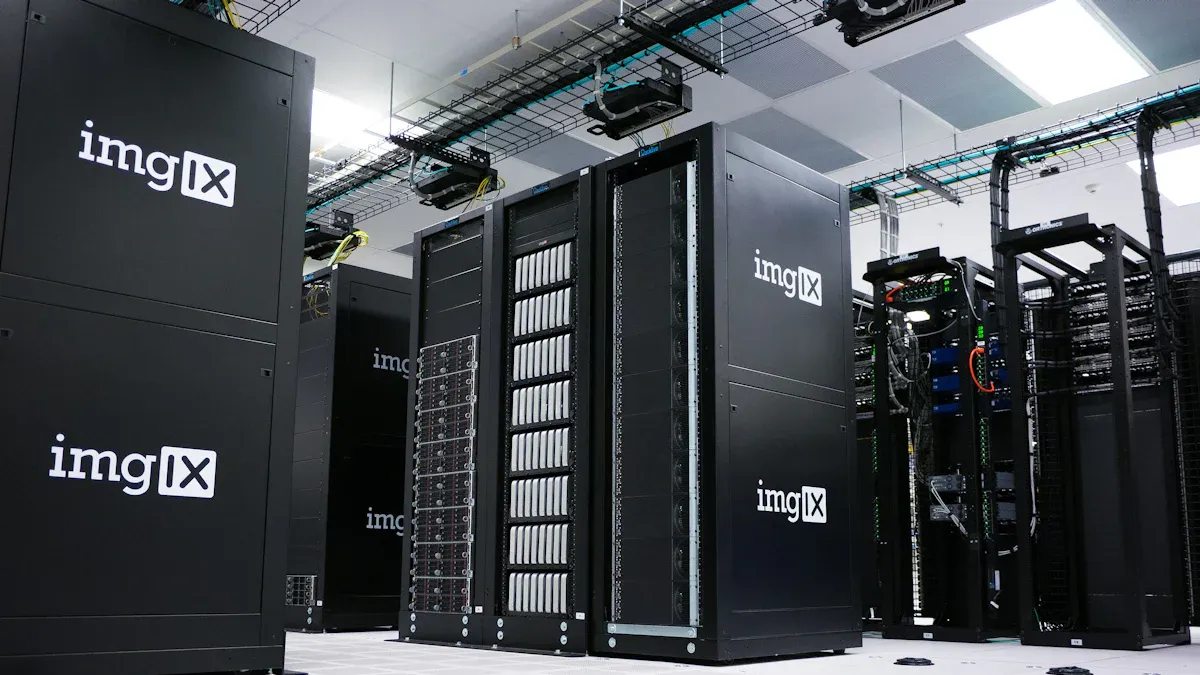
Healthcare IT systems demand uninterrupted power to maintain HIPAA compliance and protect sensitive data. A monitored PDU ensures operational continuity by capturing critical power metrics and identifying issues like distortions. Proactive power management reduces downtime, enhances energy efficiency, and safeguards critical systems, making it indispensable for healthcare environments.
Key Takeaways
- Monitored PDUs provide steady power, which is needed to follow healthcare rules like HIPAA.
- Live monitoring and alerts from PDUs help IT teams fix power problems fast. This lowers downtime and keeps patient data safe.
- Picking a good monitored PDU with tools like remote control and environment checks can improve work and follow healthcare rules better.
Understanding Healthcare IT Compliance
Key Standards and Regulations (HIPAA, HITECH)
Healthcare IT compliance revolves around adhering to critical regulations like HIPAA and HITECH. The Health Insurance Portability and Accountability Act (HIPAA) establishes stringent guidelines for protecting patient health information (PHI). It mandates secure data handling, ensuring confidentiality, integrity, and availability of sensitive information. Non-compliance can lead to severe penalties, loss of patient trust, and reputational damage.
The Health Information Technology for Economic and Clinical Health (HITECH) Act complements HIPAA by promoting the adoption of electronic health records (EHRs). It incentivizes healthcare providers to implement secure IT systems while imposing stricter penalties for data breaches. For example, a national pharmacy chain revised its policies to safeguard PHI on insurance cards, demonstrating the importance of compliance in daily operations.
Regulatory bodies like the U.S. Department of Health and Human Services (HHS) and the Office for Civil Rights (OCR) enforce these standards. They ensure healthcare organizations meet compliance requirements, reducing risks associated with data breaches and operational inefficiencies.
| Regulation | Description |
|---|---|
| HIPAA Compliance | Stricter regulations with severe consequences for non-compliance. |
| Price Transparency Rule | Requires hospitals to disclose pricing information, increasing compliance burdens. |
Role of IT Infrastructure in Compliance
A robust IT infrastructure plays a pivotal role in achieving healthcare compliance. Health Information Systems (HIS) enhance data management, streamline operations, and reduce medical errors. These systems provide healthcare professionals with better access to patient information, enabling informed decision-making and improving care quality.
Studies show that advanced IT systems significantly reduce compliance-related costs and time-to-market. For instance, pharmaceutical companies using regulatory analytics reported a 23% decrease in compliance costs and a 5.2-month reduction in time-to-market. However, challenges like high implementation costs and privacy concerns must be addressed to maximize the benefits of IT infrastructure.
Monitored PDUs contribute to compliance by ensuring uninterrupted power supply to critical IT systems. They enhance system reliability, reduce downtime, and support adherence to regulations like HIPAA. By integrating real-time power monitoring and remote management, these devices safeguard sensitive healthcare data and maintain operational continuity.
Challenges in Securing Healthcare IT Systems

Risks of Power Disruptions and Downtime
Power disruptions pose a significant threat to healthcare IT systems. Frequent outages can compromise critical operations, especially in facilities with limited resources. Studies have shown that power failures in healthcare environments correlate with increased mortality rates. For instance:
- A study at Jinja Referral Hospital reported 150 patient deaths over six months due to electricity failures, projecting an annual total of 300 deaths.
- Mortality risk increases by 43% for each day power outages exceed two hours.
These statistics highlight the importance of reliable power solutions. Monitored PDUs play a crucial role in mitigating these risks by ensuring uninterrupted power supply and providing real-time alerts for potential issues.
Threats to Data Security and Compliance
Healthcare IT systems are prime targets for cyberattacks, often resulting in data breaches that compromise sensitive patient information. The following table illustrates the scale of such incidents:
| Incident | Year | Individuals Affected | Nature of Compromised Data |
|---|---|---|---|
| Community Health Systems | 2014 | 4.5 million | Social Security numbers, dates of birth, phone numbers |
| UCLA Health System | 2015 | 4.5 million | Patient records (unencrypted) |
| TRICARE | 2011 | 4.9 million | Social Security numbers, phone numbers, home addresses |
| Excellus BlueCross BlueShield | 2015 | 10 million | Medical data, Social Security numbers, financial information |
| Premera Blue Cross | 2015 | 11 million | Medical information, bank account numbers, Social Security numbers |
| Anthem Blue Cross | 2015 | 78.8 million | Names, Social Security numbers, home addresses, dates of birth |

These breaches underscore the need for robust IT infrastructure. Monitored PDUs enhance system reliability, reducing vulnerabilities that could lead to data loss or non-compliance with regulations like HIPAA.
Operational Impacts of Non-Compliance
Non-compliance with healthcare regulations can result in severe operational and financial consequences. Organizations face significant costs, including:
- Legal fees, which escalate in cases involving multiple individuals or disputes.
- Data recovery expenses, which depend on the breach’s size and complexity.
- Operational disruptions, leading to downtime, reduced productivity, and business interruptions.
These challenges emphasize the importance of investing in reliable IT solutions. Monitored PDUs not only ensure operational continuity but also simplify adherence to regulatory standards, safeguarding both patient data and organizational reputation.
How Monitored PDUs Support Compliance
Real-Time Power Monitoring and Alerts
Monitored PDUs provide real-time power monitoring, enabling healthcare facilities to track energy usage and identify anomalies instantly. This capability ensures that critical systems remain operational by detecting potential power issues before they escalate. Alerts generated by these devices notify IT teams of irregularities, such as voltage fluctuations or overloads, allowing for immediate corrective action. This proactive approach minimizes risks associated with power disruptions, ensuring compliance with healthcare regulations like HIPAA.
Remote Management for Risk Mitigation
Remote management features offered by monitored PDUs enhance risk mitigation strategies. IT administrators can access and control power distribution systems from any location, reducing the need for on-site interventions. This capability proves invaluable in healthcare environments where uninterrupted operations are critical. For example, remote management allows for load balancing, which distributes power evenly across devices, reducing the likelihood of outages. By enabling swift responses to power-related issues, monitored PDUs support the continuous operation of essential healthcare systems.
Enhancing System Reliability and Uptime
Monitored PDUs significantly improve system reliability and uptime, which are vital for healthcare IT compliance. Facilities utilizing these devices report a 15% reduction in outages due to features like failover power and advanced alerting. Failover power ensures uninterrupted operations during power failures, while advanced alerting minimizes downtime through proactive notifications. The following table highlights key features and their impact on reliability and uptime:
| Feature | Impact on Reliability and Uptime |
|---|---|
| Load Balancing | Reduces risk of outages by distributing power evenly |
| Failover Power | Ensures uninterrupted operations during power failures |
| Advanced Alerting | Minimizes downtime through proactive notifications |
| Reported Outage Reduction | Facilities using intelligent PDUs report a 15% reduction in outages |
| Runtime Statistics | Intelligent PDUs have logged over 1.5 billion hours of runtime |
These features demonstrate how monitored PDUs enhance operational continuity, ensuring compliance with stringent healthcare regulations.
Benefits of Monitored PDUs in Healthcare IT

Ensuring Operational Continuity
Healthcare facilities rely on uninterrupted power to maintain critical IT systems. Monitored PDUs play a pivotal role in ensuring operational continuity by providing real-time power monitoring and advanced alerting capabilities. These features allow IT teams to identify and address potential power issues before they escalate, reducing the risk of downtime. For instance, load balancing capabilities distribute power evenly across devices, preventing overloads and ensuring consistent performance. By maintaining a stable power supply, monitored PDUs help healthcare organizations avoid disruptions that could compromise patient care and data integrity.
Simplifying Regulatory Adherence
Compliance with healthcare regulations, such as HIPAA and HITECH, requires robust IT infrastructure. Monitored PDUs simplify regulatory adherence by ensuring the continuous operation of systems that store and process sensitive patient data. Remote management features enable IT administrators to monitor and control power distribution from any location, reducing the likelihood of non-compliance due to power-related failures. Additionally, these devices generate detailed reports on power usage and system performance, which can be used to demonstrate compliance during audits. This proactive approach minimizes the risk of penalties and enhances the organization’s reputation.
Strengthening Data Security
Data security is a top priority in healthcare IT. Monitored PDUs contribute to this by enhancing system reliability and reducing vulnerabilities. Performance indicators, such as error rates, response times, and the frequency of aborted transactions, provide valuable insights into potential security threats. The following table highlights these indicators and their significance:
| Performance Indicator | Description |
|---|---|
| Error Rates | Indicates the frequency of errors in DICOM transactions, which can signal potential security issues. |
| Response Times | Measures the time taken for responses in DICOM communications, affecting the efficiency of data transfer. |
| Frequency of Aborts/Rejects | Tracks how often transactions are aborted or rejected, highlighting possible misconfigurations or security threats. |
By addressing these issues proactively, monitored PDUs help healthcare organizations safeguard sensitive data and maintain compliance with stringent regulations.
Best Practices for Deploying Monitored PDUs
Choosing the Right Monitored PDU
Selecting the appropriate monitored PDU is critical for healthcare IT environments. Facilities must evaluate features that align with their operational needs. For instance, IP aggregation reduces deployment costs by allowing multiple PDUs to share a single IP address. Environmental monitoring ensures optimal conditions by tracking heat and moisture levels, preventing equipment failures. Remote connectivity enables IT teams to monitor power consumption and configure alerts, minimizing downtime risks. Additionally, out-of-band communication provides a backup option for managing power systems during network failures. The table below highlights key features to consider:
| Feature | Description |
|---|---|
| IP Aggregation | Reduces deployment costs by allowing multiple PDUs to share a single IP address. |
| Environmental Monitoring | Proactively monitors conditions like heat and moisture to ensure optimal operation. |
| Remote Connectivity | Enables remote access to monitor power consumption and configure alerts to prevent downtime. |
| Out-of-Band Communication | Provides redundant communication options if the primary network fails. |
| DCIM Access | Offers a single access point for real-time power and environmental data, improving efficiency. |
Effective Deployment Strategies
Deploying monitored PDUs effectively requires careful planning. Intelligent PDUs are essential for power monitoring and environmental management in healthcare IT. Facilities should prioritize capacity planning to prevent server shutdowns and failures. High-density data centers benefit from innovative technologies like intelligent PDUs, which maintain uptime and efficiency. Positioning PDUs strategically within racks ensures even power distribution, reducing the risk of overloads. Additionally, integrating PDUs with Data Center Infrastructure Management (DCIM) systems provides real-time insights into power usage, enhancing operational efficiency.
Maintenance and Monitoring Protocols
Regular maintenance and monitoring protocols ensure the long-term reliability of monitored PDUs. IT teams should establish schedules for inspecting power connections, testing failover systems, and updating firmware. Proactive monitoring of runtime statistics and environmental conditions helps identify potential issues before they escalate. Facilities should also document maintenance activities to streamline audits and demonstrate compliance with healthcare regulations. By adhering to these protocols, organizations can maximize the lifespan of their PDUs and maintain uninterrupted operations.
The healthcare sector’s reliance on digital technologies highlights the critical role of monitored PDUs in maintaining compliance and protecting sensitive data. These devices ensure reliable power distribution, enabling uninterrupted data storage and processing. Their advanced features, such as real-time monitoring and control, safeguard patient care by minimizing downtime and enhancing operational reliability.
FAQ
What is a monitored PDU, and why is it important in healthcare IT?
A monitored PDU is a power distribution unit with real-time monitoring capabilities. It ensures uninterrupted power supply, critical for healthcare IT compliance and operational reliability.
How do monitored PDUs help with regulatory compliance?
Monitored PDUs provide real-time power data and alerts. These features simplify adherence to regulations like HIPAA by ensuring system uptime and safeguarding sensitive patient information.
Can monitored PDUs reduce downtime in healthcare facilities?
Yes, monitored PDUs minimize downtime by detecting power anomalies early. Their advanced alerting and failover capabilities ensure continuous operation of critical healthcare systems.
Post time: Apr-07-2025

